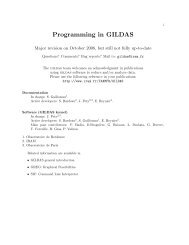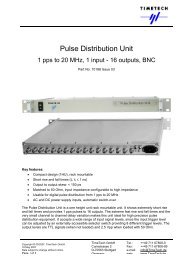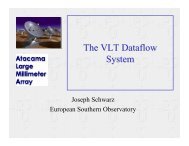class Continuum and Line Analysis Single-dish Software - IRAM
class Continuum and Line Analysis Single-dish Software - IRAM
class Continuum and Line Analysis Single-dish Software - IRAM
Create successful ePaper yourself
Turn your PDF publications into a flip-book with our unique Google optimized e-Paper software.
3.3. CONTINUUM AND SKYDIP PROCESSING 25<br />
CUBE <strong>and</strong> GRID can also produce images or tables of several mathematical functions of the<br />
input spectra rather than simple channel maps. Please refer to the internal help for details.<br />
For mapping purpose, <strong>class</strong> is able to produce images at the gildas format. gildas (the<br />
Grenoble Image <strong>and</strong> <strong>Line</strong> Data <strong>Analysis</strong> System) is an set of routines which is able to process<br />
images of up to four dimensions. It contains a variety of routines to transpose, resample, reproject,<br />
smooth, add, merge, divide, etc... images, <strong>and</strong> a superset of greg which allows to produce contour<br />
plots from these images. Other programs can also do false color displays of the images on image<br />
processors.<br />
3.2.7 Miscellaneous<br />
• DIVIDE makes the ratio of the R <strong>and</strong> T spectra. The two spectra must have the same velocity<br />
scale.<br />
• FFT plots the power spectrum of the current observation. It might help identify spurious<br />
ripples. Editing of the fourier transform is possible, so that these ripples may be suppressed.<br />
• NOISE generates a Gaussian noise as intense as in the current spectrum using the rms value<br />
determined by the BASE comm<strong>and</strong>, or using a rms value given as an argument. NOISE<br />
Value NEW will create a noisy spectrum of given noise level into R, after copying R in T.<br />
• RESAMPLE resamples the R spectrum on the specified grid. If the final sampling is coarser<br />
than the original one, a smoothing occurs to the final sampling.<br />
• SMOOTH operates a Hanning smoothing by default <strong>and</strong> divide the number of channels by two.<br />
Other arguments can be specified to use other methods. SMOOTH AUTO uses a sophisticated<br />
variable-resolution algorithm, but it requires the channels to be really independent <strong>and</strong><br />
this is apparently seldom the case in radio astronomy. SMOOTH GAUSS Width convolves the<br />
spectrum by Gaussian of given Width in current units; it does not take care of bad channels.<br />
SMOOTH BOX N make the average of N adjacent channels <strong>and</strong> divides the number of channels<br />
by N.<br />
3.3 <strong>Continuum</strong> <strong>and</strong> Skydip Processing<br />
3.3.1 <strong>Continuum</strong><br />
So far, we have h<strong>and</strong>led only Spectroscopic data, but <strong>Continuum</strong> data can be processed by <strong>class</strong><br />
. Currently, only continuum drifts can be reduced. The basic idea is to treat continuum drifts<br />
as spectra would be. Accordingly, very few comm<strong>and</strong>s behave differently in <strong>Continuum</strong> <strong>and</strong><br />
Spectroscopy modes.<br />
<strong>Continuum</strong> mode is accessed by typing the SET TYPE CONTINUUM comm<strong>and</strong>. The prompt then<br />
changes to CAS> (<strong>Continuum</strong> <strong>Analysis</strong> System). You can return to Spectroscopy mode later on<br />
typing the SET TYPE SPECTROSCOPY or LINE comm<strong>and</strong> <strong>and</strong> the prompt changes to LAS> (<strong>Line</strong><br />
<strong>Analysis</strong> System).<br />
Some comm<strong>and</strong>s have slightly different behaviour in Spectroscopy <strong>and</strong> <strong>Continuum</strong> modes.<br />
• SET UNIT has no effect in <strong>Continuum</strong> mode.<br />
• SET ANGLE also controls the plotting units in <strong>Continuum</strong> mode.<br />
• METHOD: only GAUSS <strong>and</strong> CONTINUUM methods are allowed in <strong>Continuum</strong> mode.






